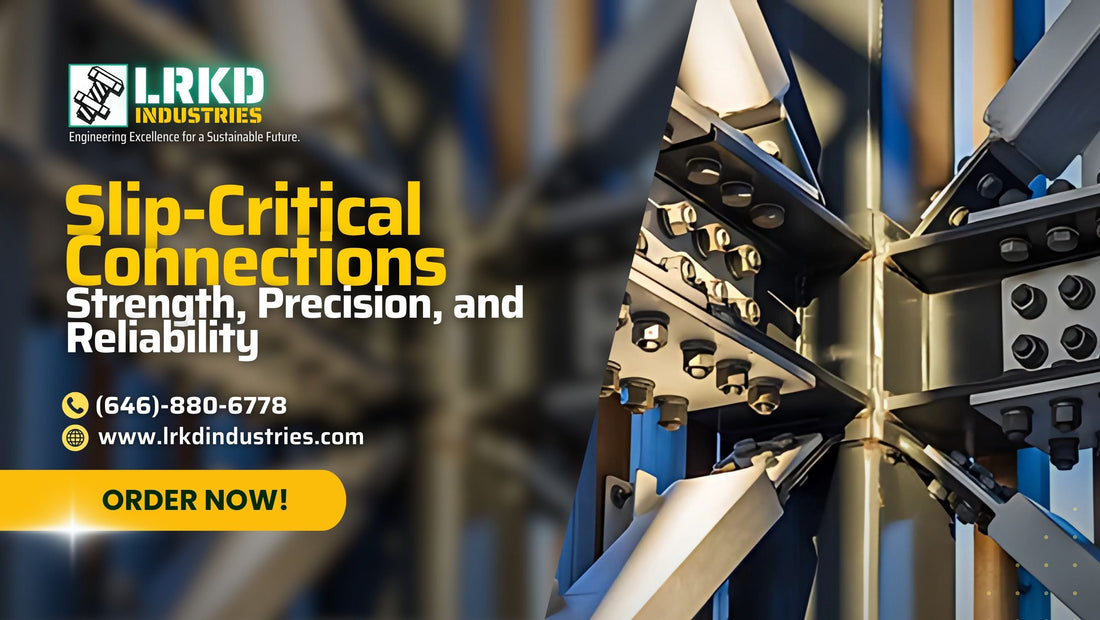Imagine constructing a massive steel bridge or a high-rise building. Every bolt, every joint, and every connection plays a crucial role in ensuring the structure's safety and longevity. Among these, slip-critical connections are one of the most vital yet often misunderstood aspects of structural engineering. But what exactly makes them so important?
Slip-critical connections ensure that bolted joints resist movement under load by relying on friction instead of shear strength. Unlike standard bolted joints, where the bolts bear the load, these connections use high-tension bolts to create a clamping force that prevents slippage. This mechanism provides unparalleled reliability in high-stakes applications, such as bridges, towers, and industrial buildings.
In this guide, we'll explore the science behind slip-critical connections, their benefits, design specifications, and load capacities, ensuring you have all the essential information to make informed decisions.
What Is a Slip-Critical Connection?
A slip-critical connection (formerly called friction-type connection) is a bolted joint where the load is transferred through friction between the faying surfaces rather than through bolt shear or bearing. The goal is to prevent any relative movement between the connected parts.
Slip-critical connections are commonly used in:
Steel Bridges – Prevents slip under dynamic loads like traffic and wind.
High-Rise Buildings – Ensures stability under high wind loads and seismic activity.
Transmission Towers – Supports loads with minimal deformation over time.
Cranes and Heavy Machinery – Withstands constant motion and stress cycles.
Key Design Considerations
For a slip-critical connection to perform optimally, several factors must be carefully managed:
1. Surface Preparation
The friction force in a slip-critical connection depends on the condition of the faying surfaces. Different surface treatments impact slip resistance:
|
Surface Condition |
Slip Coefficient (μ) |
Common Application |
|
Class A – Cleaned, unpainted |
0.30 |
Bridges, high-rise buildings |
|
Class B – Blasted, painted with approved coatings |
0.50 |
Industrial structures |
|
Galvanized (without treatment) |
0.20 |
Electrical towers |
Ensuring the right surface roughness and cleanliness enhances friction and prevents slippage under load.
2. Bolt Tensioning
Slip-critical connections rely on properly tensioned bolts. High-strength bolts such as ASTM A325 and ASTM A490 are commonly used.
|
Bolt Type |
Tensile Strength (ksi) |
Pre-Tensioning Requirement (kips for 3/4" bolt) |
|
ASTM A325 |
120 |
28 |
|
ASTM A490 |
150 |
40 |
Proper tensioning methods include:
Turn-of-nut method – Rotating the nut after snug-tight.
Calibrated wrench method – Using a torque wrench for precise tension.
Direct tension indicators (DTIs) – Washers that deform under the correct load.
3. Load Capacities and Factors of Safety
The ability of a slip-critical connection to sustain loads depends on bolt diameter, slip coefficient, and pre-tensioning force. The general formula for slip resistance is:
Where:
P_s = Slip resistance (lbs)
μ = Slip coefficient
N = Number of bolts
T = Tension force per bolt
|
Bolt Diameter (inches) |
Slip Capacity per Bolt (kips, Class B Surface) |
|
3/4" |
24 |
|
7/8" |
32 |
|
1" |
40 |
|
1 1/8" |
50 |
Ensuring the correct bolt size and surface preparation maximizes the connection's efficiency and durability.
Advantages of Slip-Critical Connections
Why choose slip-critical connections over standard bearing-type joints?
✅ No Load Redistribution: Since the load is transferred via friction, there’s no bolt shear stress or elongation over time.
✅ Superior Performance Under Dynamic Loads: Perfect for high-impact environments such as bridges, railways, and industrial plants.
✅ Prevention of Joint Slip: Eliminates movement that can lead to structural failures.
✅ Long-Term Stability: Minimizes the risk of fatigue and wear, enhancing structural lifespan.
Challenges and Best Practices
Despite their advantages, slip-critical connections have some challenges. Here’s how to mitigate them:
1. Ensuring Proper Installation
Use the correct tensioning method to achieve full preload.
Verify surface conditions to meet Class A or B friction standards.
Inspect bolts regularly to confirm they maintain proper tension.
2. Accounting for Environmental Factors
Corrosion protection is crucial for longevity. Use galvanized or coated bolts in harsh environments.
Adjust for temperature variations, as extreme heat or cold can affect tensioning.
3. Balancing Cost and Performance
While slip-critical connections require more precision, they reduce long-term maintenance costs by preventing wear and tear.
Evaluate project needs to determine whether slip-critical connections are necessary or if standard bolted joints suffice.
Conclusion & Takeaways
Slip-critical connections are indispensable in high-load, high-risk applications. To ensure their success:
Select the right bolt type and surface condition for optimal friction.
Follow precise tensioning methods to prevent slippage.
Regularly inspect and maintain connections to extend structural lifespan.
By understanding these principles, engineers and construction professionals can build safer, longer-lasting structures. Whether you're working on a bridge, a high-rise, or heavy machinery, applying best practices for slip-critical connections will enhance durability, safety, and performance.
Slip-Critical Bolted Connections
Built for Strength. Engineered for Precision. Trusted for Reliability.
When it comes to structural integrity, nothing is left to chance. Slip-critical connections are designed to deliver maximum performance in applications where joint slippage is not an option. These connections rely on the friction between clamped surfaces to resist loads—making the quality, tension, and finish of every bolt absolutely critical.
At LRKD Industries, we provide a wide selection of high-performance fasteners engineered for slip-critical applications, including our Tension Control Bolts and Structural Hex Bolts. These bolts are rigorously tested and compliant with industry standards, ensuring every connection performs exactly as it should—under pressure, over time.
Slip-critical assemblies are commonly used in bridges, high-rise buildings, and seismic zones where movement could compromise safety. Proper bolt installation and surface preparation are essential to achieving full connection strength and compliance with AISC and ASTM guidelines.
Contact LRKD Industries today to ensure your next project meets the highest standards for structural safety and bolt reliability.
👉 Need fastener recommendations for a slip-critical design? We’re here to help.
📍 Address: 98 N Industry CT, Deer Park, NY 11729, US
📞 Phone: +1 646-880-6778
📧 Email: info@lrkdindustries.com
Explore our full range of Tension Control Bolts and Structural Hex Bolts designed specifically for slip-critical applications.


